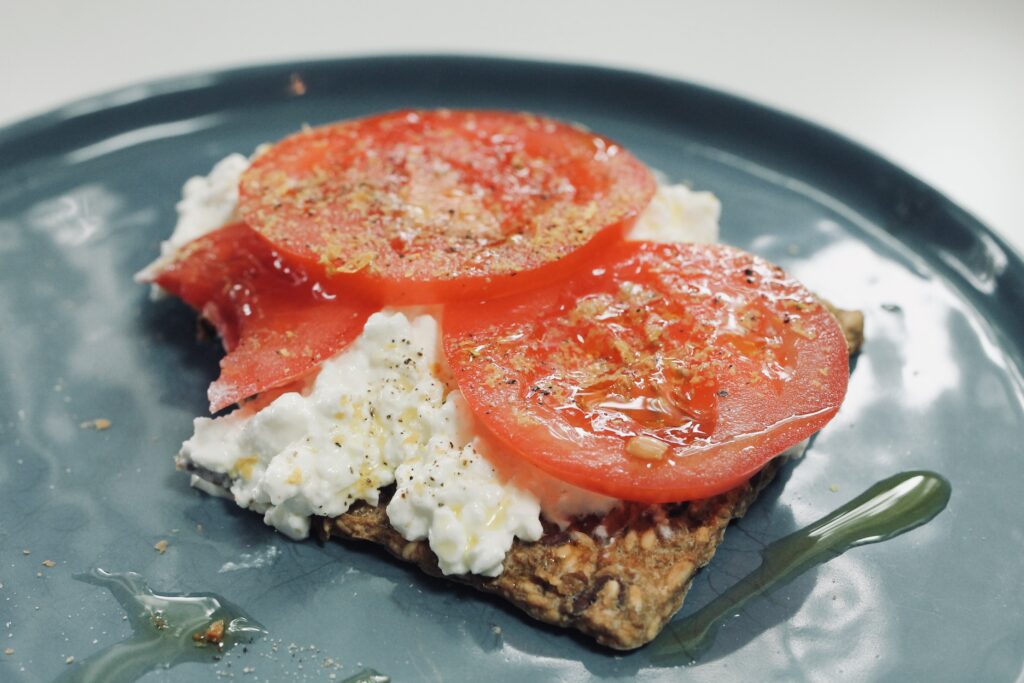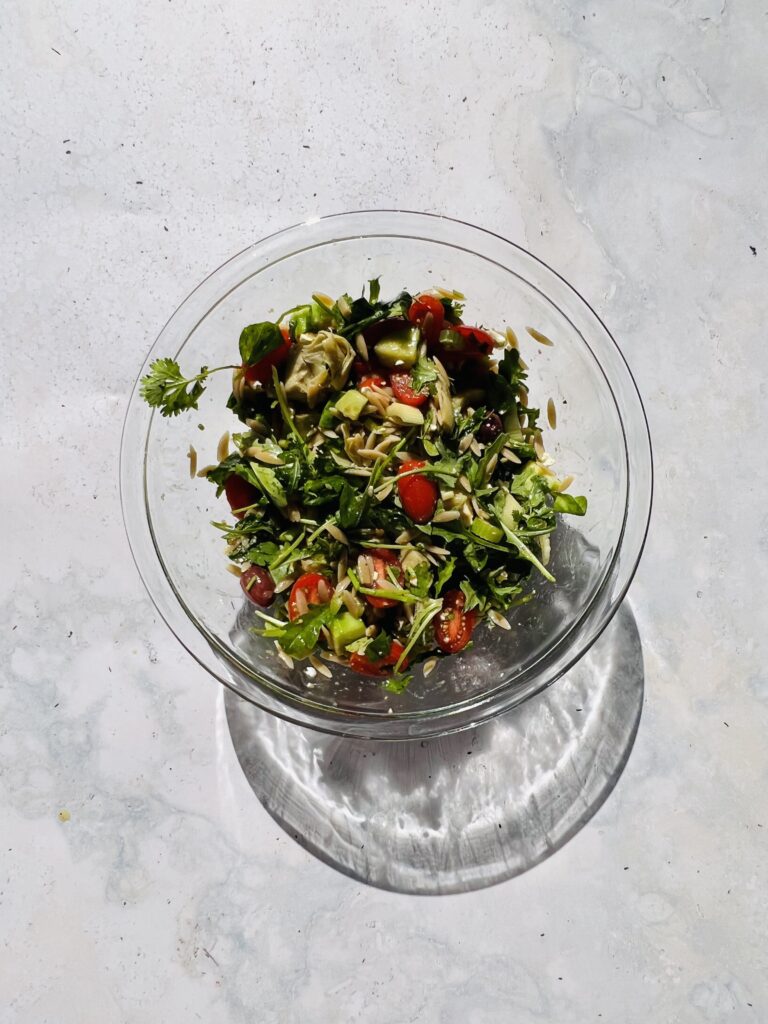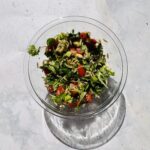There’s a reason (in fact, many!) why the Mediterranean diet is a global phenomenon. But if we take a step back, it’s much more of a lifestyle than a diet. This way of eating is also a way of living. Honoring local, seasonal, and simple ingredients, it’s a satisfying and healthy approach to food. As a whole, the Mediterranean diet nourishes your body from the inside out. Think: heart health, blood sugar regulation, and more. What better way to celebrate this style of eating than with a 20 minute Mediterranean pasta salad? Made with whole wheat orzo, a variety of colorful veggies, and tangy feta cheese, this dish pleases a crowd—or in my case, my hungry family. It’s delicious as an entree, alongside grilled chicken, or plated with steamed fish. It’s light yet satisfying—a recipe for any summery occasion.
Watch the Instagram Reel, here!
what is the mediterranean diet?
Despite its name, there is no official Mediterranean diet—not in the sense that there’s an Atkins diet. Rather, the Mediterranean diet is more of a lifestyle. It’s based on the traditional cuisines of Greece, Italy and other countries that border the Mediterranean Sea. Plant-based foods, such as whole grains, vegetables, legumes, fruits, nuts, seeds, herbs and spices, are the foundation of the diet. Olive oil is the main source of added fat. Fish, seafood, dairy and poultry are included in moderation. Red meat and sweets are eaten occasionally.
4 health Benefits of the Mediterranean diet
Research shows that those who live along the Mediterranean Sea consistently live longer. Although Greeks, Spaniards, and Italians don’t share the same diet, their nutrition has a lot in common. They eat the Mediterranean way. They emphasize an abundance of fresh produce, plant-based protein (legumes, beans, and nuts), fish, healthy fats, and whole grains. Of the many reasons to eat the Mediterranean way, these are the top four reduces inflammation, lowers the risk of heart disease, protects against cancer, and helps manage diabetes.

how to build a plate, the mediterranean way
Mediterranean recipes embrace vibrant foods. For simplicity’s sake, consider these four principles:
- Build meals around leafy green vegetables, beans, legumes, fruit, and nuts
- Eat high-quality, omega-3 rich fish at least twice per week (think: sardines, anchovies, salmon, etc.)
- Choose lean poultry and pasture-raised eggs in moderation
- Use extra-virgin olive oil, regularly

What is Pasta Salad?
Pasta salad is a salad dish prepared with one or more types of pasta, almost always chilled, and most often tossed in a vinegar, oil, or mayonnaise-based dressing. It is typically served as an appetizer, side dish or a main course. For this Mediterranean pasta salad, you’ll use olive oil as the vinaigrette’s base.
Ingredients for this mediterranean pasta salad
It doesn’t get more delish (or simple) than this vegetarian, 20 minute Mediterranean pasta salad. Below are the ingredients you’ll need.
Whole Wheat Orzo
You can use any type of pasta, but I prefer this small-rice shaped pasta. DeLallo’s whole wheat version packs a bit more protein and fiber in every bite.
Marinated Artichoke hearts
Soaked in herbs and olive oil, marinated artichoke hearts provide the best flavor.
Kalamata Olives
Salty and briny, what would a Mediterranean-inspired salad be without olives?
Cherry tomatoes
Cherry tomatoes are summer’s candy. A small variety of tomato, they’re named for their cherry-like shape. This veggie ranges in color: red (the most common), yellow, orange, green, or almost black. They’re in season from May through October, depending on where you live. Here in Colorado, they’re currently in peak season.
Celery
Crunchy and salty, celery adds a pop of green and fiber to this pasta salad.
Cucumber
Refreshing and light, cucumber provides hydration and antioxidants.
Arugula
Mildly spicy, arugula adds a “peppery” taste to this dish. You can sub this for spinach, massaged kale, or another leafy green of choice.
Feta cheese
Crumbly with a slightly grainy texture, feta is formed into large blocks and aged in brine. Its flavor is tangy and salty, ranging from mild to sharp. Feta is often used as a table cheese in Greek salads.
Fresh Herbs
Aromatic herbs bring the ultimate punch of flavorful and freshness to any savory dish—especially a cold pasta salad. For this recipe, be sure to use tender herbs (basil, dill, chives, cilantro, etc.).
Extra-Virgin Olive Oil
When it comes to olive oil, don’t skimp on quality. Given that this recipe has such few ingredients, using high-quality olive oil is key. For this recipe, I’m using Garcia de la Cruz extra-virgin olive oil. It’s organic, comes directly from Spain, had as a fruity yet mild flavor profile. Be sure to buy olive oil that comes in dark-colored glass bottle or stainless steel container. This will protect the oil from exposure to sunlight.
Balsamic vinegar
A rich, complex sweetness, traditional balsamic offers a mellow tartness rather than a strong acidity. I’m using Brightland’s Rapture vinegar which has blackberry undertones!
Lemon Juice
For acidity and brightness!
Dijon mustard
If I’m making a homemade vinaigrette, it almost always as dijon mustard. This adds creaminess and a sharp mustard flavor (without being overpowering).
Black pepper
Freshly cracked black pepper adds the perfect kick to this otherwise mildly-flavored dish. Use sparingly or liberally in this recipe, depending on your palate.

How to make Mediterranean pasta salad
- Cook your pasta, according to the package.
- In a large bowl, make your vinaigrette.
- Chop your veggies and herbs (I prefer to peel my cucumber, but that’s a personal preference!).
- Once the pasta is done cooking, rinse and drain under cold water.
- Add the orzo and remaining ingredients to the bowl.
- Mix well.
- Eat immediately or store in the fridge for a few hours.

20 Minute Mediterranean Pasta Salad
Ingredients
Vinaigrette
- 1/4 cup olive oil
- 2 tablespoons balsamic vinegar
- 1 tablespoon dijon mustard
- 1/2 lemon, juiced
- black pepper to taste
Pasta Salad
- 3/4 cup whole wheat orzo
- 1 cup arugula
- 3/4 cup cherry tomatoes, chopped
- 1/2 cup cucumber, chopped
- 1/2 cup marinated artichoke hearts
- 1/3 cup celery, chopped
- 1/4 cup fresh herbs
- 1/4 cup kalamata olives
- 1/4 cup crumbled feta cheese
Instructions
- Cook orzo according to the package. Rinse and drain.
- Meanwhile, chop and assemble veggies and herbs.
- In a large bowl, whisk together vinaigrette: olive oil, balsamic, dijon mustard, lemon juice, and black pepper.
- Add remaining ingredients, including orzo and feta cheese.
- Serve immediately or enjoy a few hours after making.
Images courtesy of Unsplash. This article contains affiliate links. Thank you for supporting Wellness with Edie. This article is for informational purposes only. It is not, nor is it intended to be, a substitute for professional medical advice, diagnosis, or treatment and we recommend that you always consult with your healthcare provider.



Leave a Reply